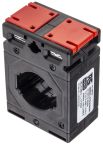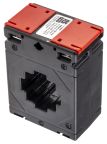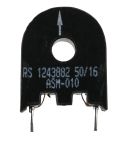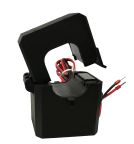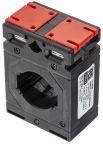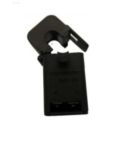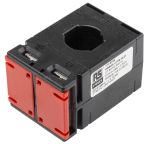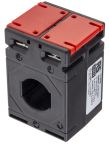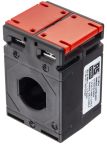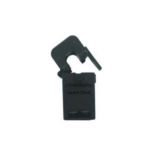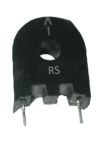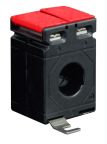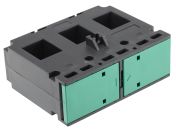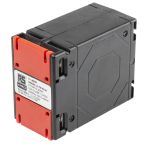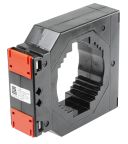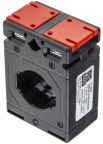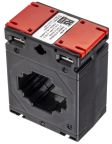Current Transformers
Current Transformers (CTs) play an indispensable role in the electrical infrastructure of the Philippines, transforming high currents from power lines into lower, more manageable values.
In regions like Luzon, where industrial activities are concentrated, current transformers facilitate the monitoring and managing of electrical loads to prevent overloads and disruptions. Furthermore, in areas prone to natural disasters, such as typhoons, which can impact electrical stability, the precise operation of these transformers helps in quick recovery and continuous power supply management.
These products are engineered to uphold stringent standards, ensuring that they operate effectively and reliably to enhance the safety and efficiency of the Philippines' electrical infrastructure.
How Does a Current Transformer Work?
Learn about the operation, key components, and essential functions of current transformers:
- Principle of Operation: Current transformers operate on the principle of magnetic induction. As primary current flows through the primary winding, it generates a magnetic field. This field induces a proportional but smaller current in the secondary winding, effectively transforming the current to a safer level.
- Components: The Alternating Current (AC) transformer includes the core, primary winding, and secondary winding. The core, usually made of ferromagnetic materials such as silicon steel, focuses on the magnetic field generated by the primary winding. On the other hand, the primary winding has a limited number of turns, making it possible for the current to be measured without disconnecting it from the supply or load. Whereas the secondary winding contains many coil turns wound on a low-loss laminated magnetic core. This large cross-sectional area core ensures low magnetic flux density, even with a smaller wire cross-section, effectively stepping down the current regardless of the load.
- Functionality: Unlike voltage transformers that alter voltage levels to meet appliance requirements, AC current transformers are designed to measure and convert current. They step down high current levels from the primary to a lower level in the secondary, facilitating accurate, current monitoring and enhanced safety in electrical systems. Once the current has been reduced, it can be safely monitored and measured using an Ammeter.
Types of Current Transformer (CT meter)
There are several types of current transformers, each designed for different electrical applications. Delve into the various types below:
1. Toroidal Current Transformer
In the shape of a doughnut, these transformers are designed without having a primary winding as part of their construction. Rather, a toroidal current transformer has a window or hole through which the current flows in the network.
2. Wound Current Transformer
With primary windings physically connected line to line with the conductor, wound current transformers provide accurate current measurement. This design integrates the conductor bringing the measured current through the circuit, ensuring reliable performance in various electrical systems.
3. Bar-type Current Transformer
In a bar-type current transformer, the cable or busbar of the main circuit acts as the primary winding, effectively creating one turn. In most cases, these transformers are bolted directly to current-carrying devices and are fully insulated from high operating voltages.
4. Split Core Current Transformer
For enhanced practicality in installation, a split core current transformer can be quickly clipped around a conductor. This design allows for easy setup without the need to disconnect the circuit, facilitating straightforward integration into existing systems.
5. Clip-On Type Current Transformer
Typically, compact and well-suited for non-intrusive current monitoring, clip-on current transformers easily clamp around individual wires or conductors, allowing for measurements without interrupting the circuit. While some clip-on designs share similarities with split-core CTs, they may differ in specific construction details.
Applications of Current Transformers
CTs are used in a wide range of industrial and commercial measurement applications. Some of the most common are:
- Generating Stations: In places where electricity is produced, current transformers help ensure that the amount of power generated matches what is needed without going over capacity. This helps keep the electricity grid stable and prevents outages.
- Electrical Substations: These transformers are used in substations to accurately monitor how much electricity is flowing through the system. This information helps manage the distribution of electricity from power plants to homes and businesses, ensuring it is done smoothly and safely.
- Commercial Electric: Current transformers are also used for metering in commercial buildings to keep a close watch on electricity usage. This helps businesses in the Philippines manage their electrical costs better by providing precise data on consumption, which is useful for reducing energy usage.
- Power Distribution: These devices are also vital in the networks that distribute electricity across different areas. Current transformers measure the amount of electricity in the lines, helping to prevent the system from becoming overloaded, which can cause blackouts.
- Electrical Panels: In electrical panels, these transformers monitor the current passing through circuits. They help detect when there is too much current, which could lead to equipment damage, and prompt quick action to cut the power and avert potential hazards.
Usually, ammeters and current transformers are used in conjunction, with the current transformer being designed to deliver a maximum secondary current equivalent to the ammeter deflection at full scale. It is common for current transformers to have inverse turn ratios between their primary and secondary windings. Therefore, CT calibrations are usually geared towards a specific type of ammeter.
Choosing the Right Current Transformer
Selecting the right current transformer is key to maintaining a safe and efficient electrical system. Here's how to make sure you pick the best one for your needs:
First, choose a transformer type that suits your operational needs, like monitoring energy usage or protecting equipment. It's also important that the transformer's current rating matches the usual flow of electricity in your system to avoid any overloads.
Additionally, the CT ratio, which tells you how the current is scaled down for measurement, should fit your specific equipment to ensure the readings are accurate.
Lastly, don't overlook the accuracy class, especially if you’re using a current transformer for meters—accurate readings are vital for correct billing and keeping your system running smoothly.
By considering these points, you'll choose a transformer that does its job well and supports your electrical system's needs.
Explore the Range of Current Transformers at RS
To meet the Philippine’s diverse electrical needs, RSoffers an extensive range of highly accurate current transformers in various transformer types, current ratings, CT ratio supply voltages and mounting types to suit every application. These electrical devices are sourced from industry-leading current transformer suppliers in the Philippines like Siemens, Murata Power Solutions, and of course our inhouse brand, RS PRO.
Browse the broad range of current transformers available from leading suppliers, including essential accessories like industrial plugs and power relays. These complementary products ensure a complete setup for your electrical system needs. Place your order today to benefit from next-day delivery. For a full suite of delivery services, please refer to our Delivery page.
